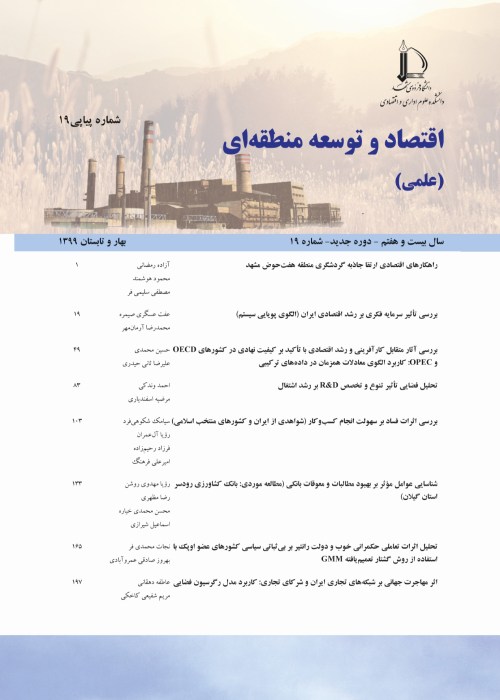Study Regional Development in the Third to Eleventh (1981-2013) Governments in Iran
That inequality in the allocation of material resources by governments across regions, other than marginalizing distributive justice, causes many social and economic problems that create other abnormalities in society. Among the abnormalities that could be due to the lack of balanced development are the emergence and increase of poverty, unemployment, infrastructure and service failures, environmental threats, and demographic misconceptions (Rafeeian, 2012:2). The main goals and objectives of the present paper are to rank the provinces based on development and allocation of funds aspects in the third to eleventh governments, measurement and separation of three budgets; total, developmental, current (volume of government) in the development of regions. Therefore, to policymaking in the direction of regional equilibrium, the effects of each will be obtained in the form of regression models and also, it will be determined which provinces have been able to develop further due to the relative share of the budget (budget efficiency in development). It is possible to achieve this by adjusting the allocation budgets of the provinces in order to regulate balanced development in the regions. Among the other factors studied in the current paper are the application of regional planning model and effective management approach in regional development. For developed and undeveloped provinces, efficient management is more important for allocating budgets.
The present paper was conducted in two stages. In the first stage, the available data for the variables studied were collected in the statistical journal. After sorting and categorizing data for regional equilibrium, 21 indicators and 151 sub-indicators were formed. A matrix of 31 * 21 was obtained after forming the provinces and then the whole country matrices. Later, by weighing each of the indicators according to the Delphi method, the ranking was obtained from the level of development of the provinces of the country in the TOPSIS software environment. To complete this section, using the cluster model, and according to the degree of enjoyment and deprivation of provinces, they were classified into 6 different groups. Also, at this stage, the ranking of budget allocations in the period considered for the provinces was also obtained and efficient provinces were also identified according to the development and budget of the provinces and the budget efficiency indicator in development. In addition, according to the "Regional Development Planning" model, the provinces were divided into two levels of developed and deprived provinces in terms of thirst in budget and effective management or mismanagement, and budget saturation.In the second stage, based on the existence of three variables, namely total budget, development budget, current budget (government volume), whose annual data were extracted from the Statistical Centre for each provinces, three simple regression models were formed. With the help of Eviews software, in the form of a data panel model, for each of the variables mentioned above, a coefficient of development was obtained and the effect of each variable was measured on the basis of its development.
The software output from the TOPSIS model indicated that Tehran and Ilam provinces were the most developed and least-favored provinces in the country, respectively. Also, in this section, an estimate of the average provincial budget allocation was made. In this regard, the provinces of Tehran and Semnan were placed at the top and at the end of the table, respectively. Also, in the case of regional development, by forming a cluster model, the provinces were classified in six clusters: the most developed cluster with only Tehran province; the developed cluster,, the relatively developed cluster, the relatively deprived cluster, the deprived cluster, with 3, 4, 5, and 17 provinces respectively while the very deprived cluster had only Ilam province. Therefore, it can be said that approximately 74% of the provinces in the second half of the clusters were among the deprived provinces and 26% of the provinces were among the developed provinces.In the second part of the research, according to the development index extracted for the provinces, the other 3 variables: "total budget", "development budget" and "government volume (current budget)" were introduced and then their effects on development were measured by three independent regression models.The development budget had a higher positive effect on development than the overall budget, while the volume of government had a negative and reverse effect on development. In other words, with rising costs, development continued to decline. Therefore, it can be stated that in Iran, the lower the current costs and government volume, the higher the indicators of development. Another significant point in this research is the 10-fold and positive effect of developmental budget to the total budget and the 12-fold negative and reverse effects of increasing the volume of government volume to the total budget on development.
The present study shows that development in Iran has been distributed in an unbalanced way. The effect of various factors on the development of provinces has also been different. Some provinces have been more affected by the developmental budget and macro-provincial efficient management. Moreover, by increasing the volume of government, the development has slowed down.
- حق عضویت دریافتی صرف حمایت از نشریات عضو و نگهداری، تکمیل و توسعه مگیران میشود.
- پرداخت حق اشتراک و دانلود مقالات اجازه بازنشر آن در سایر رسانههای چاپی و دیجیتال را به کاربر نمیدهد.


